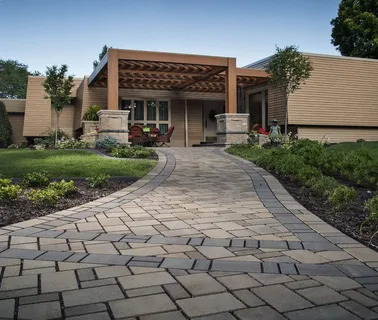Is your paver walkway starting to look tired, stained, or uneven?
Many homeowners across the U.S. deal with the same frustrations, pavers shifting, weeds growing through the gaps, and color fading fast after just one harsh winter or rainy season.
You invest time and money to create that perfect outdoor look. But without the right upkeep, even the most professionally installed paver walkway can lose its charm and strength. The good news? You don’t need to overhaul it. A few smart, expert-backed strategies can help you bring back its clean look, and make it last for years.
Let’s break down six proven hacks that experts use to keep a paver walkway in top shape. These are quick to follow, practical, and tailored for U.S. homeowners who want their outdoor spaces to always look their best.
Fix the foundation early
If your pavers are sinking or shifting, the issue starts below the surface. Poor drainage or a weak base can ruin even the best materials. Re-set sunken pavers by lifting them out and adding bedding sand underneath. Use a plate compactor to press them into place. Compacting the surface again after repairs keeps everything tight.
Wash, but with care
High-pressure washing seems easy. But blasting water at full force can loosen sand and damage the top layer of your pavers. Use a pressure washer with a fan tip nozzle. Keep the water flow even. Set the PSI below 2000. Clean in small sections, and always follow with sand re-application in the joints.
Seal it right
Every two to three years, seal your paver walkway. This simple task protects against water damage, UV rays, and stains. Choose a breathable, penetrating sealer instead of a film-forming one. That way, moisture won’t get trapped underneath. Sealing also brings out the natural color and adds strength.
Natural maintenance like this fits into a broader picture too. Natural climate solutions could remove up to 7 gigatons of CO₂ annually by 2030, which is almost one-third of what’s needed to reach the 1.5°C target. Smart upkeep on your end—using sealers that prevent runoff or choosing sand that avoids erosion—also helps align your outdoor choices with a greener footprint.
Keep weeds and ants out
You can’t stop nature, but you can block it from creeping into your walkway.
- Use polymeric sand instead of regular joint sand. It hardens when wet.
- Apply sand evenly after cleaning or repairs. Sweep it into all joints.
- Mist lightly with water. Let it cure fully.
- Inspect joints every season and top up as needed.
Check the slope
Water should always run off, not pool. If water sits on the paver walkway, check the slope. A slight angle (1/8 inch per foot) is enough for water drainage. You may need to regrade or re-lay sections. Poor slope also leads to freeze-thaw damage in colder regions. Spot it early to save bigger costs later.
Clean spills fast
Oils, rust, and organic matter can leave permanent marks. Act quickly. For oil, use a degreaser meant for pavers. For rust, use an acid-free rust remover. Avoid vinegar or harsh acids, they wear down the surface. Always test cleaners in a small area. Rinse with mild water and use a stiff brush, not wire.
Final thoughts
Your paver walkway doesn’t have to be high-maintenance. Just a few expert hacks, like sealing it often, keeping the slope right, and choosing the correct joint sand, can make a huge difference.
When you build a solid base and follow up with seasonal checks, the walkway won’t just look better, it will perform better too. In fact, making small efforts regularly can save you from major repairs later.
These steps may seem simple, but they protect your space against time, weather, and wear. So next time you walk outside, your path will still feel new, clean, and built to last.
PAVER WALKWAY






